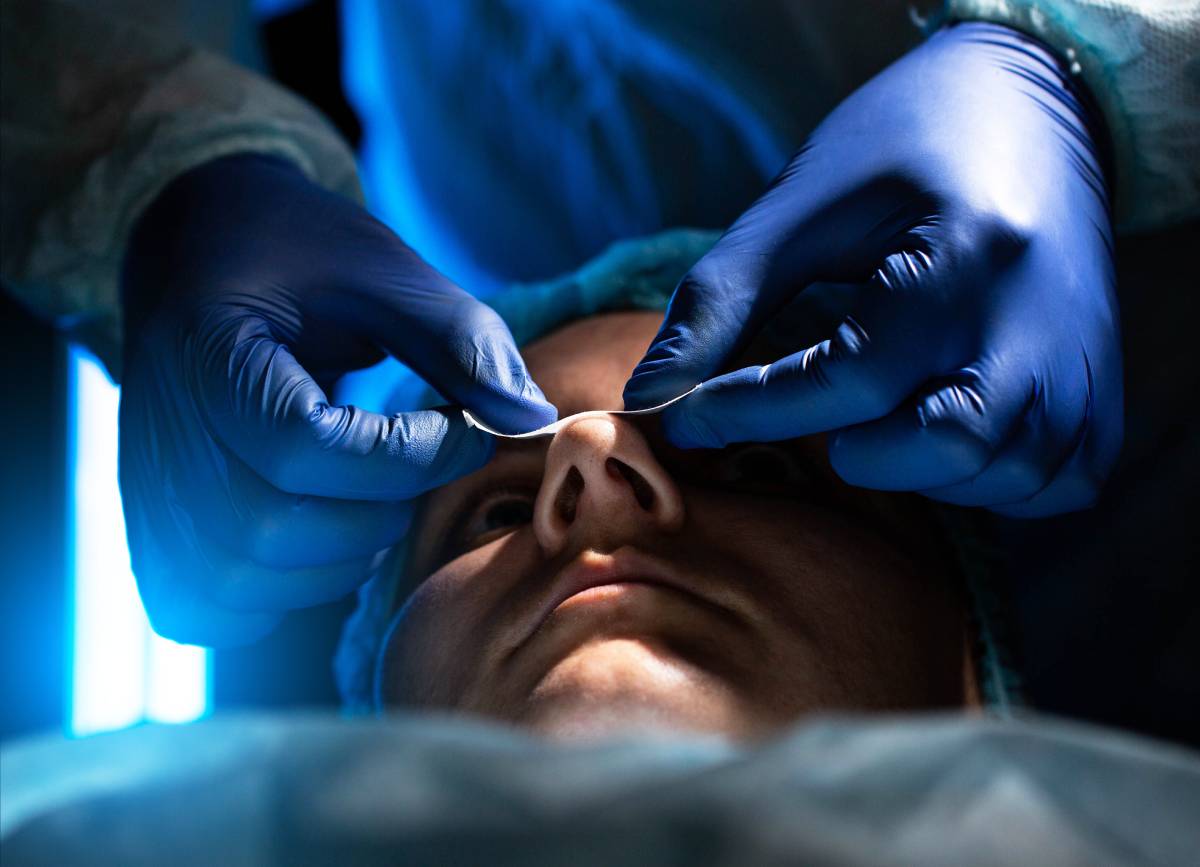Anatomical studies indicate that around 75 to 80% of people experience some degree of septal deviation [1]. Accordingly, septoplasty is one of the most common procedures performed in otolaryngology [2]. The objective of septoplasty is to create a straight, stable, and appropriately sized caudal septal plate at the bony-cartilaginous junction of the nasal dorsum [1]. While it is a relatively safe and effective procedure, knowledge of proper technique, possible complications, and anesthesia considerations are essential to a successful septoplasty.
The clearest indication that a patient requires septoplasty is septal deviation with subsequent symptomatic nasal obstruction [2]. Without the latter element, septoplasty is typically not necessary [2].
To assess whether septoplasty is necessary and ensure that it can be performed safely, the preoperative exam is crucial. Before surgery, the physician should acquire a detailed patient history, with information spanning prior trauma, nasal decongestant use, and subjective sense of nasal airway obstruction [3]. To prevent intraoperative bleeding–one of the most common complications of septoplasty–adequate vasoconstriction and mucosal decongestion are key [1, 3]. Endoscopic examination is another beneficial preoperative tool, given how surgeons can use it to accurately locate the precise location of septal deviation and gauge its severity [3]. With all of this information, physicians will be best primed to choose the best septoplasty technique that suits not only their patient but also their particular skillset [2, 3].
Another important choice that must be made in preparing for septoplasty is the choice of anesthetic technique. Often, general anesthesia (GA) is the technique of choice for septoplasty [4]. Its benefits are many: Recent innovations in GA have rendered it safer and contributed to increasing patient satisfaction scores [4]. It is also particularly beneficial to surgeons because GA prevents potentially disruptive movements from the patient and completely eliminates the need for perioperative patient cooperation [5]. However, it is also associated with serious side effects, can contribute to prolonged hospitalization, and, consequently, lead patients to incur high costs [5].
As a result, multiple recent studies have focused on the feasibility of local anesthesia (LA) during septoplasty. In a case study focused on a 34-year-old septoplasty patient, Obradovic found that LA alleviated pain well [4]. The procedure was ultimately safe and successful [4]. According to Obradovic, the key to an effective LA-based septoplasty is the infiltration of the anesthetic near or precisely within the surgical site [4].
Furthermore, Vermisili et al. conducted a meta-analysis of studies comparing GA and LA [5]. They found that LA contributed to a comparably high quality of life as GA in septoplasty patients; however, patients who received GA reported higher satisfaction with their healthcare [5]. This discrepancy could be at least partially explained by GA patients’ tendency to remain in the hospital longer, leading to greater interaction with the medical team and more attentive monitoring [5]. Ultimately, however, researchers consider local anesthesia a useful, low-risk, and cost-effective means of pain control in septoplasty [6].
Following surgery, splints should be removed within 2 to 7 days [3]. During the postoperative period, patients should take an antibiotic that protects against Staphylococcus aureus to avoid the onset of toxic shock syndrome [3]. By taking these steps, along with the aforementioned recommendations, surgical teams can perform a successful septoplasty.
References
[1] J. Dabrowska-Bień et al., “Complications in septoplasty based on a large group of 5639 patients,” European Archives of Oto-Rhino-Laryngology, vol. 275, p. 1789-1794, May 2017. [Online]. Available: https://doi.org/10.1007/s00405-018-4990-8.
[2] S. P. Most and S. F. Rudy, “Septoplasty: Basic and Advanced Techniques,” Facial Plastic Surgery Clinics, vol. 25, no. 2, p. 161-169, May 2017. [Online]. Available: https://doi.org/10.1016/j.fsc.2016.12.002.
[3] M. Lupa et al., ”Chapter 1 – Septoplasty,” in Atlas of Endoscopic Sinus and Skull Base Surgery. United States: Elsevier, 2019, ch.1, pp. 3-10.e1. [Online]. Available: https://doi.org/10.1016/B978-0-323-47664-5.00001-8.
[4] B. Obradovic, “Septoplasty Under Local Anesthesia,” Journal of Craniofacial Surgery, vol. 30, no. 2, p. e142-e143, March/April 2019. [Online]. Available: https://doi.org/10.1097/SCS.0000000000005071.
[5] S. Vermisli et al., “Quality of life and patient satisfaction following septoplasty: comparison of general and local anesthesia,” Allergy and Rhinology, vol. 17, no. 3, July 2021. [Online]. Available: https://doi.org/10.5152/B-ENT.2021.20516.
[6] B. K. Nguyen et al., “Perioperative Analgesia for Patients Undergoing Septoplasty and Rhinoplasty: An Evidence-Based Review,” The Laryngoscope, vol. 129, no. 6, p. E200-E212, December 2018. [Online]. Available: https://doi.org/10.1002/lary.27616.
